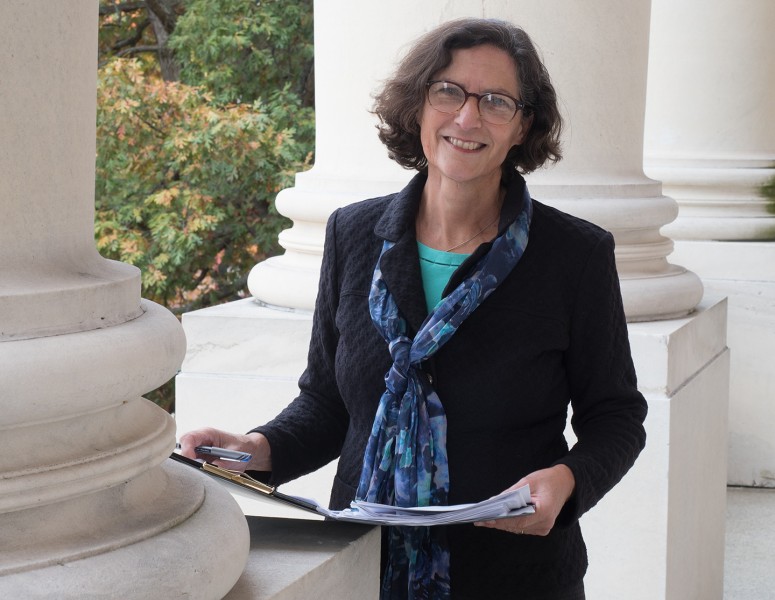By Timothy B. Wheeler
Bay Journal
Dru Schmidt-Perkins figured she’d put two years into launching a new nonprofit in Maryland dedicated to fighting suburban sprawl.
Nineteen years later, she’s finally left the helm of 1000 Friends of Maryland. Sprawl hasn’t been defeated, by any means, but it’s been slowed and even halted for the time being in some places.
Schmidt-Perkins doesn’t claim sole credit for that — the Great Recession that began a decade ago dampened development pressure considerably — but she does believe her group has played a key role in steering Maryland’s growth.
“We changed the debate about it,” she said, sitting in her group’s Baltimore rowhome offices on her last day as executive director. “It used to be you had to grow to thrive; it was the key to economic development. And now, much more, it’s about where you grow.”
Technically, 1000 Friends of Maryland only had about 200 friends when it debuted in 1998. Modeled on similarly named “friends” groups in Oregon and Florida, the Maryland organization got its start as a loose bunch of planners and preservationists who came together to back “Smart Growth” legislation that then-Gov. Parris Glendening pushed through the General Assembly in 1997. Schmidt-Perkins, as a veteran campaigner with Clean Water Action, had been part of the coalition backing the initiative, and the next year she took over as 1000 Friends’ first executive director.
Sprawl was a big issue
Sprawl was a big political issue at the time, and Smart Growth aimed to curb it by steering state funds for highways, schools and other infrastructure to existing communities. Critics of sprawl focused their wrath on Chapman’s Landing, a 4,600-home development proposed on a wooded stretch of the Potomac River in Charles County. By the time 1000 Friends held its first formal meeting in fall 1998, Glendening had blocked the development already arranged to purchase the 2,200-acre Chapman’s tract for a whopping $25 million in state funds, with an additional $3 million in foundation money.
Other battles followed over what opponents characterized as similar out-sized or out-of-place developments around the state. Through it all, Schmidt-Perkins made it clear 1000 Friends was not about stopping growth, but about seeing it done in a way that was cost-effective and “environmentally sane,” as she put it in 1998. Indeed, the group counted some developers among its friends and board members — those interested in urban redevelopment, mainly.
Another major dispute flared up over Terrapin Run, a 4,300-home development proposed in 2005 in rural, mountainous Allegany County. Critics argued that such a massive project so far from schools and other services was out of keeping with the county’s comprehensive plan, or growth blueprint. County officials desperate for any growth stuck with the developer, so 1000 Friends joined with the grassroots opponents to fight it.
“Dru was very helpful to us,” said Dale Sams, a retired paper mill executive who was a leader of the citizens’ group opposing Terrapin Run. He has since become chairman of 1000 Friends’ board.
The Terrapin Run controversy inspired a push for legislation to make Maryland localities follow their comprehensive plans, as opponents argued that development was out of synch. Schmidt-Perkins, already a regular presence in Annapolis during the General Assembly, backed the successful bill.
That didn’t stop Terrapin Run, which managed to fend off legal and political challenges. But the project failed to get off the ground as the recession closed in.
The economic downturn that began in 2008 proved to be a wake-up call for some localities, Schmidt-Perkins said, as citizens and local officials alike “realized that low-density residential development doesn’t pay for itself, that scattered housing doesn’t generate enough tax revenues to pay for the highways, schools and emergency services needed to serve those additional people.”
Restrictions on septic systems
Concern over the environmental and fiscal impact of rural sprawl inspired more legislation in 2012, backed by then-Gov. Martin O’Malley, which required Maryland counties to curtail residential development on household septic systems. That’s slowed, if not prevented the construction of several large new subdivisions in outlying rural areas. But some counties stretched or ignored the guidelines. Schmidt-Perkins said she came to the realization around then that “we can pass great state laws, but they weren’t being implemented correctly locally.”
Another battle in Charles County, over saving one of the Chesapeake Bay’s best fish nurseries, marked a turning point of sorts. The county had proposed intensive development in the Mattawoman Creek watershed, threatening its ecological health. 1000 Friends joined with grassroots groups there to help push for rewriting the county’s comprehensive plan to scale back growth. Schmidt-Perkins credits Kim Brandt, a planner recruited to be the group’s local policy director, with playing a role in the long but ultimately successful campaign. Brandt has branched out since to work in like fashion in other counties.
“Through Charles County, we learned that through engaging in the actual development of the comprehensive plan, you get a good plan, good tier maps (limiting septic-based growth) and now regulations to sustain that comprehensive plan,” Schmidt-Perkins said.
Never-ending battles
The job of ensuring sane growth is never-ending, though, and some developer’s dreams never die. Allegany County officials are now in the process of changing the zoning in that western Maryland county to allow a smaller but still inappropriate development along Terrapin Run, according to Sams.
And in Annapolis, Smart Growth has gone virtually underground under Gov. Larry Hogan, who ran an Annapolis development firm before his election in 2014. Hogan has eased regulations governing septic-based development, and pushed to build more and wider highways in rural areas. The state Department of Planning, meanwhile, is “being decimated,” Schmidt-Perkins said, undermining the agency’s ability to generate the land use and demographic data that lawmakers need to make informed decisions about transportation, schools and other projects.
On the plus side, she credits Hogan with restoring funding for land preservation, and for pressing legislation to make it harder for governors and legislators to raid those funds in future. But, she notes, Maryland’s Program Open Space does not make up for poorly planned development. “You can’t buy your way to smart growth,” she said.
Lately, Schmidt-Perkins has been working with farm interests, local officials, and environmentalists to find a balance between renewable energy development and rural preservation, as solar panels sprout where corn and soybeans once did. That debate isn’t resolved, either, but Schmidt-Perkins has decided it’s time for 1000 Friends to have a fresh leader. At 59, she stressed, she hasn’t retired, but is just looking for a change.
New leadership
John Campagna, who’s spent decades corralling private investment for environmental restoration and worked in a variety of other nonprofit posts, took over Monday as the group’s new executive director. On Wednesday (Nov. 8), activists, current and former elected leaders and business leaders celebrated Schmidt-Perkins at a historic former factory in Baltimore that’s being redeveloped into a modern office building – an example of the kind of growth she’s long supported.
“I’ve had the greatest gig,” Schmidt-Perkins said, as 1000 Friends grew to speak for more than a thousand voices. Looking ahead, she said she hasn’t ruled out staying involved somehow in smart growth issues, since they connect to so much else that matters. “Growth done badly is expensive,” she pointed out, “for the environment, and for county and state budgets.”
twheeler@bayjournal.com
Bay Journal is published by Bay Journal Media, a 501(c)(3) nonprofit, to inform the public about issues that affect the Chesapeake Bay. A print edition is published monthly and is distributed free of charge. News, features and commentary are available free online at bayjournal.com. MarylandReporter.com, also a 501(c)(3) nonprofit news organization, is partnering with the Bay Journal by publishing one of its articles every Friday.






Recent Comments